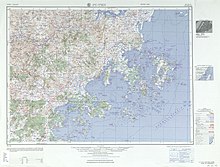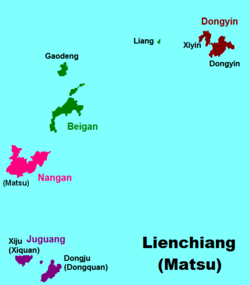|
Juguang, Lienchiang
Juguang Township / Jyuguang Township[3][4][5] (Chinese: 莒光鄉; Hanyu Pinyin: Jǔguāng Xiāng; Tongyong Pinyin: Jyǔguang Siang; Wade–Giles: Chü3-kuang1 Hsiang1; Foochow Romanized: Gṳ̄-guŏng-hiŏng), also spelled Chukuang, is a rural township of Lienchiang County (the Matsu Islands), Republic of China (Taiwan). Juguang Township includes two major islands, Dongju Island (東莒 "East Ju"; Dĕ̤ng-gṳ̄) and Xiju Island (西莒 "West Ju"; Să̤-gṳ̄),[6] as well as some islets. NameOn October 15, 1971, the Executive Yuan approved changing the name of the township from Baiquan Township (Paichuan, White Dogs; 白犬鄉) to Juguang Township (Chukuang; 莒光鄉). They also approved changing the name of Xiquan Island (Hsichuan; 西犬島) to Xiju Island (Hsiju; 西莒島) and Dongquan Island (Tungchuan; 東犬島) to Dongju Island (Tungchu; 東莒島).[7][8] The islands were renamed based on a quote of a speech by Chiang Kai-shek, "forget not that you're in Ju" (毋忘在莒; Wú wàng zài Jǔ; Ù uông câi Gṳ̄). It refers to the City of Ju, where the king of Qi prepared a counterattack that retook his country from the State of Yan. This is an analogy of Matsu and Taiwan generally as bases of the Republic of China (ROC) to regenerate itself and one day recover mainland China from the Chinese Communist Party.[citation needed] Dongju and Xiju Islands were previously named Dongquan (Tung-ch'üan Tao[9]/Tung-ch'uan Tao[6] 東犬; Dĕ̤ng-kēng) and Xiquan (Hsi-ch'üan Tao[9]/Hsi-ch'uan Tao[6] 西犬; Să̤-kēng) Islands, meaning "Eastern Dog" and "Western Dog" respectively. They have also been called the White Dogs[10] (Paichuan, Baiquan) or White Dog Islands (白犬島; Băh-kēng-dō̤) or Baiken Islands (白肯島). The name Baiquan (白犬) has been connected with the homophonous name Baiquan (白畎).[3]: 29 HistoryOn May 15, 1617, sixty-nine wokou were captured alive in the area.[11] In 1872, construction of Dongsha (Tungsha) Lighthouse (Dongquan Lighthouse) began.[12] In December 1939, Japanese naval forces from Taiwan occupied the islands.[13] The islands were originally part of the Changle County before the ROC government evacuated to Taiwan. It is considered by the People's Republic of China government as part of Changle City of the Fuzhou City. In September 1953, the Changlo County (長樂縣) government was established on the islands.[14] Western Enterprises (西方公司), a CIA front organization, had a communications base on Xiquan (Hsichuan).[15] After a series of combat readiness tests carried out by MAAG were completed on April 15, 1955, the overall Chinese Nationalist defense preparations for the Matsu Islands were rated as satisfactory. One of the weaknesses noted was "the seriously understrength regiment garrisoning the Paichuan (White Dog) Islands group".[16] In July 1956, the islands were transferred to Lienchiang County. The islands were divided into two townships: Xiquan and Dongquan.[17] On August 19, 1958, President Chiang Kai-shek visited Xiju Island (then Xiquan) and spoke to the soldiers there.[3]: 465, 488 [13] In September 1960, the two townships were united into one, Paichuan (Baiquan) township.[18] On July 23, 1964, Chiang Ching-kuo visited the islands.[3]: 468 On October 15, 1971, the Executive Yuan approved changing the name of the township from Baiquan Township (Paichuan, White Dogs; 白犬鄉) to Juguang Township (Chukuang; 莒光鄉). They also approved changing the name of Xiquan Island (Hsichuan; 西犬島) to Xiju Island (Hsiju; 西莒島) and Dongquan Island (Tungchuan; 東犬島) to Dongju Island (Tungchu; 東莒島).[7][8] On December 30, 1977, the 6-ton fishing boat Kuanghua 16638 was slammed by a communist vessel near the Liuchuan reefs (劉泉礁) off the coast of Chukuang.[19] On September 21, 1979, and on May 3, 1980, President Chiang Ching-kuo visited the township.[20] On June 18, 1993, President Lee Teng-hui visited the Dongju Elementary School.[3]: 480 [21] On June 24, 2001, Typhoon Chebi caused 3,000,000 yuan of damage on the islands.[3]: 486 In the 2018 election, Mayor Hsieh Chun-Lan (謝春欗) was re-elected mayor, defeating her opponent Chen Shun-Shou (陳順壽) by over a hundred votes. Hsieh called for rebuilding the former township office as a resort, beautification of the township, and creation of a vibrant sight-seeing economy.[22] In 2020, undersea communications cables between Nangan and Juguang were damaged by sand dredgers from mainland China on five occasions, disrupting phone and internet services.[23] Geography  Dongju (Tong Chu[24]), the southernmost of the Matsu Islands, is 2.63 km2 and Sijyu 2.36 km2. Islets includes like Yongliu (永留嶼 Yongliu) near Dongju. Dongju is shaped like a dagger, while Xiju a triangle, so seemingly bigger on maps. Some cliffs of Dongjyu is severely corroded by wind, creating a strangely aesthetic appearance. Other islands include Linaoyu (林坳嶼) also known as Lintouyu (林頭嶼),[25] Xiniuyu (犀牛嶼), Dayu (大嶼), Xiaoyu (小嶼), and Sheshan (蛇山).[26][27] The northernmost and easternmost points of Juguang Township are on Dayu, the westernmost point is on Sheshan, and the southernmost point is on Linaoyu.[1][3]: 49 Linaoyu is also the southernmost point of the Matsu Islands.[28] Juguang is across from Meihua Town (梅花镇), Changle District, Fuzhou, Fujian, China (PRC).[29] Politics and governmentAdministrative divisions  Administratively the islands are part of the Lienchiang County. Neither Dongju nor Xiju has an island-wide administrative level.[30] The islands are divided into five rural villages:[31] Xiju Island
Dongju Island
Mayors
InfrastructureElectricity supply The township is powered up by Xiju Power Plant located in Xiju Island and Dongju Power Plant located in Dongju Island. Due to the changes in electricity needs, both islands were interconnected by submarine power cable since 2000.[34] Water supply Previously, water supply had been scarce in Xiju Island despite having water wells drilled around the island by the residents. Later the military built a dam and formed the Ledao'ao Reservoir for the water needs of residents, defense and irrigation.[35] Tourism The 19.5-metre (54-step) Dongquan Lighthouse on northern Dongjyu, made during the late Qing dynasty with granite. The guiding light is in the shape of a clam and can reach 16.7 nautical miles (30.9 km). Dongju Lighthouse is a second-level national historic building. In front of the lighthouse, there used to be four mist-cannon for signaling, but has now been removed and placed in Matsu Folk Culture Museum. The 42-character Dapu Inscription, in Dapu Seaport of Dongju, was made during the Wanli era of the Ming dynasty, concerning the capture of pirates alive. Remembering-the-Past Pavilion (懷古亭 Huaigu Ting) was constructed in 1966 sheltering the stone. In the sea south of the Sijyu, there is Snake Mountain (蛇山). The main island has a small Green-sail Seaport (青帆港), two water reservoirs and a middle-elementary school, but are not major tourist attractions.[36] It also features the Mysterious Little Bay. Transportation There is one accessible seaport on Xiju, and two on Dongju. Juguang can be reached by ferry from Fuao Harbor in Nangan or by helicopter which only operates during the winter and priority on which is given to local residents. EducationThere are two public elementary and junior high schools in Juguang: Lienchiang County Jingheng Junior High & Elementary School (連江縣敬恆國民中小學) is on Xiju,[37] while Lienchiang County Jinguang Township Dong Jyu Junior High & Elementary School (連江縣莒光鄉東莒國民中小學) is on Dongju.[38] National Matsu Senior High School (國立馬祖高級中學), operated by the national government, is located in Nangan.[39] Notable natives
See also
References
External linksWikimedia Commons has media related to Juguang, Lienchiang.
|
||||||||||||||||||||||||||||||||||

